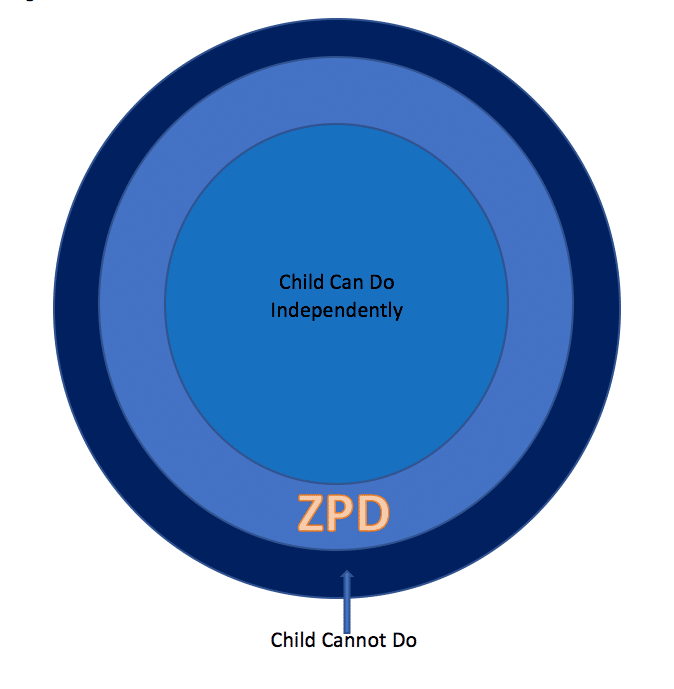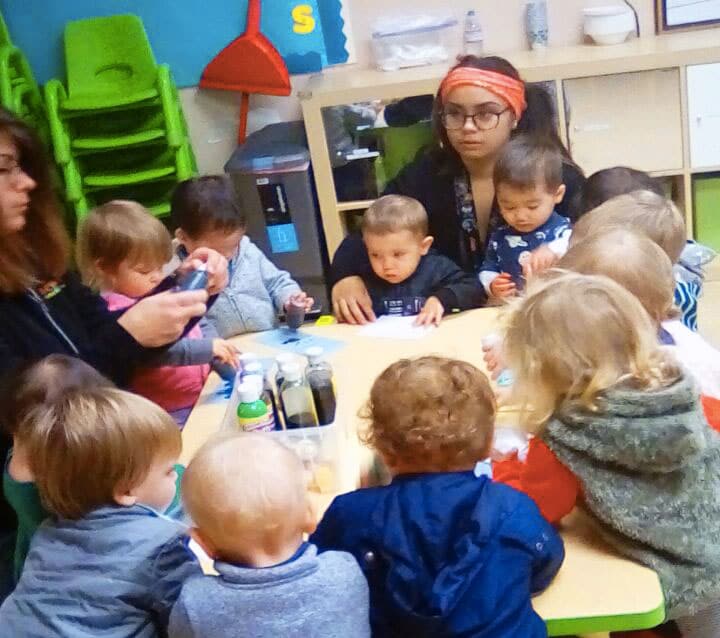A well-known concept in Early Childhood Education called the Zone of Proximal Development (ZPD) was originally introduced, though not fully developed, by psychologist Lev Vygotsky writing in Moscow almost 100 years ago. The ZPD is defined as the difference between what a young learner can do on their own without any assistance versus what they cannot do on their own and require the assistance of an adult (parent or teacher). Essentially, this “zone” is the gap between what a child knows and what he/she does not yet know. It is the space where optimal learning opportunities reside. Eventually, the child will learn the skill and no longer require the help of an adult (i.e. eating at the table) so then will move on to a new task in turn requiring assistance.

The Theory of Scaffolding
In the 1960s, Vygotsky’s unfinished research was resurrected and revived by a new group of developmental psychologists. They began studying and testing the ZPD in a number of different educational contexts including pre-school and elementary aged children. They discovered that not only is the ZPD a highly effective tool and concept, but furthermore, encouraging and supporting children to attempt the most challenging tasks inside their ZPD led to the most learning. This led to the concept of scaffolding first coined by Dr. Jerome Bruner in the 1950s or early 1960s but not appearing in psychology literature until Wood, Bruner and Ross (1976 p. 90) used it to describe how a tutor’s help allowed a pre - schooler to solve a block reconstruction problem.

Testing the Effectiveness of Scaffolding
Since the 1970s, there has been a great deal of research on the effectiveness of Scaffolding in ECE. The result of this research has been two solid conclusions…
- Scaffolding is highly effective and can help students learn much more than they would if left to more traditional teaching methods.
- It requires the educator (or guiding adult) to have a good knowledge of the child’s ZPD so that the teaching methods, activities and instructional scaffolding can be adopted accordingly.

Scaffolding Teaching Strategies
Scaffolding is one of the fundamental teaching strategies that educators (and parents) use. It is difficult to imagine children learning how to walk completely on their own or learning how to ride a bike without the use of training wheels. We would not give children a difficult text to read without first pre-teaching some key vocabulary. Here are some key strategies to effectively use scaffolding.
- Activate Prior Knowledge and Abilities
Recall that it is vitally important to know the child’s current level of knowledge or ability in order to allow teaching within their ZPD and to effectively design activities. There are a variety of ways to do this including simply observing the children over time, asking the right questions and encouraging social time and group work to find out what they can do.
- Model Learning Activities
Model the activity/task for children before they are asked to complete a similar one. Every skilled educator knows that a demonstration always beats an explanation. One way to model tasks is with the “Fishbowl Activity” where a small group in the middle of a circle (the fishbowl) engages in an activity thus modelling how it is done for the larger observing group surrounding them. Thus, it does not always have to be the educator who is the only one modeling the activity.
3. Encourage Socialization, Group Work or Cooperative Learning
Each child may not have exactly the same ZPD and it is not always possible to tailor an individualized lesson plan for each learner. Structured student interactions (both verbal and non- verbal) allows children to show and share what they already know and also to see and hear new ways to complete the task.
4. Use Visual Aides
Visual aides stimulate and motivate a learner. Suppose that an educator’s lesson on a given day is to teach colors. She knows that a child named Marsha already knows the color yellow and places a group of toys in a circle in the middle of the room. With the entire group looking on she asks Marsha to bring her all the yellow toys which Marsha happily does. Thus, she already knows Marsha’s ZPD (has an idea about colors but only knows yellow and not the others). The toys are not the outcome but only a scaffolding tool which must be thought of as temporary and meant to be removed.
The following clip demonstrates Vygotsky’s ZPD in action.
Conclusion
Vygotsky developed the ZPD theory between 1924 and 1934 and the reason it was not fully developed was because his brilliant life was cut short by a bout of Tuberculosis at the age of 37. He was a contemporary of Skinner, Pavlov, Freud and Piaget but never attained their level of eminence during his lifetime largely because of his untimely death and also because his writings were not accessible to the western world. His theories were not well-known in the west until 1958 and were not published there until 1962. But his influence has continued to grow markedly since that time. He was indeed a prolific writer publishing six books on psychology over the last ten years of his life.
Bruner’s scaffolding approach encircled and ensnared Vygotsky ZPD giving it an immortality that had eluded its original author. And Bruner (1915-2016) lived past the age of 100 ensuring that Vygotsky’s work would continue to grow in importance. Towards that end, it is important to note that the terms scaffolding, “instructional scaffolding”, “cooperative learning”, “reciprocal learning” and “guided learning” have all come to have the same meaning in today’s ECE literature as developmental psychologists apply them to the study of children’s development while educators continue to find creative ways to implement them in the classroom.
Sources
Alber, Rebecca. January 24, 2014. 6 Scaffolding Strategies to Use with Your Students
https://www.edutopia.org/blog/scaffolding-lessons-six-strategies-rebecca-alber
Freund, L. S. (1990). Maternal Regulation of Children's Problem-solving Behavior and Its Impact on Children's Performance. Child Development, 61, 113-126.
Lewis, Beth. March 27, 2017. Scaffolding Instruction Strategies.
https://www.thoughtco.com/scaffolding-instruction-strategies-2081682
Sarikas, Christine. July 10, 2018. Vygotsky Scaffolding: What It Is and How to Use It.
https://blog.prepscholar.com/vygotsky-scaffolding-zone-of-proximal-development
Saul McLeod. 2018. The Zone of Proximal Development and Scaffolding
https://www.simplypsychology.org/Zone-of-Proximal-Development.html
Vygotsky LS. Thought and Language. Kozulin A, trans. Cambridge, MA: The MIT Press; 1986. (Original work published in 1934)
Vygotsky, L. S. (1978). Mind in society: The development of higher psychological processes (M. Cole, V. John-Steiner, S. Scribner & E. Souberman., Eds.) (A. R. Luria, M. Lopez-Morillas & M. Cole [with J. V. Wertsch], Trans.) Cambridge, Mass.: Harvard University Press. (Original manuscripts [ca. 1930-1934])
Wood, D., & Middleton, D. (1975). A study of assisted problem-solving. British Journal of Psychology, 66(2), 181−191.
Wood, D., Bruner, J., & Ross, G. (1976). The role of tutoring in problem solving. Journal of Child Psychology and Child Psychiatry, 17, 89−100.
